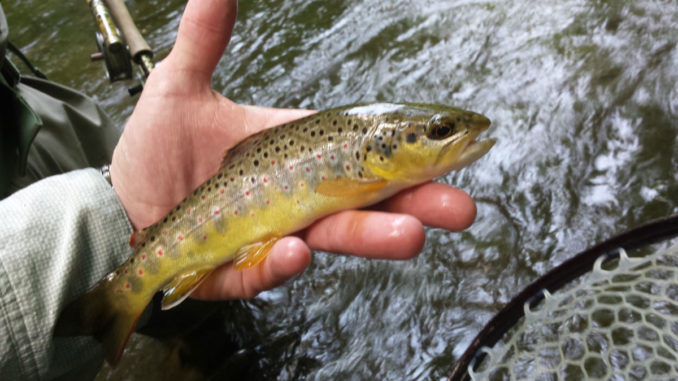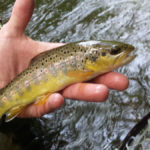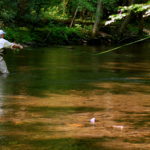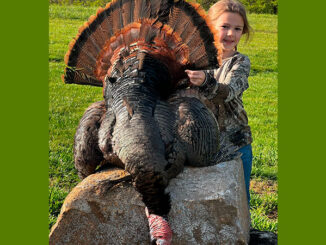
GSMNP is filled with top-drawer trout waters
If you like getting away from the crowds, enjoy beautiful surroundings and don’t mind working for your trout, consider heading for the Great Smoky Mountains National Park. The park has some great wild-trout streams, and the best ones are in the North Carolina section of the park.
Here are five of the more accessible streams:
• Oconaluftee River (NE Swain County): The Oconaluftee River is widely considered one of the top trout streams in the mountains, offering a mix of wild rainbow trout and a smaller population of brown trout.
Although heavily canopied, the Oconaluftee is a delight to fish with a fly rod, with numerous large and small pools and riffled runs, most of it easy wading. Pulloffs are numerous along US 441, providing good access. The stream does veer from the road in places, requiring a short hike across grassy fields or wooded areas.
The Oconaluftee is formed by the junction of Beech Flat Prong and Kephart Prong. It flows for about 7 miles along US 441 before entering the Cherokee Indian Reservation. The majority of the trout are small, averaging 6 to 7 inches, but they fight like trout twice their size.
Elk sightings are frequent along the lower section of the stream, especially around the visitors’ center.
• Deep Creek (Swain County): In late summer, you’ll have to share the creek with tubers in the lower section near Deep Creek Campground. Walk a mile or so — an easy walk — to the tubing cut-off point at Indian Creek, and you’ll have the stream mostly to yourself. It’s big water, marked with big pools, long, riffled runs and plenty of pocket water. Deep Creek has an equal mix of brown and rainbow trout, but it’s best known for its big browns, some in the 15- to 20-inch range. You can catch browns almost to the headwaters, which is about 14 miles from the campground.
From downtown Bryson City, turn north at the Swain County Courthouse, turn right after crossing the bridge over the Tuckasegee River, and follow the signs to the park campground, about 3 miles.
• Bradley Fork (Swain County): A tributary of the Oconaluftee River, Bradley Fork is a jewel of a stream with good numbers of rainbow and brown trout. Most of the browns are in the lower section near Smokemont Campground. A medium-size stream, Bradley Fork has a nice mix of riffles, runs, pocket water, and small plunge pools. The trout don’t get big here — 10 to 11 inches is about the maximum — but they’re plentiful. Fishing pressure is light to moderate. A good trail runs alongside the stream for about 2 miles.
From Cherokee, follow US 441 north to the entrance of Smokemont Campground (about a mile from the park entrance). Drive through the campground to a parking area for anglers at the far end. Bradley Fork Trail follows the creek about 7 miles.
• Cataloochee Creek (Haywood County): Cataloochee is not a typical mountain stream. It runs through relatively flat land and is fairly shallow, at least in the upper reaches of the valley. The stream has mostly rainbow trout with a few browns mixed in. Don’t expect a lot of large trout; they usually run under 10 inches, but some of the big pools occasionally yield larger trout. Fishing Cataloochee can be a frustrating experience at times. One day they’re hitting every fly you throw at them; the next day, nothing in your fly box will get a hit.
The big bonus here is the scenery and the wildlife. Cataloochee Valley is a miniature Cades Cove. Deer and wild turkeys are plentiful, and the valley has the only resident herd of elk in the state.
From I-40 west, take Exit 20, turn left on US 276 and turn right on Little Cove Road. Follow the signs to the park. Once you’re inside the park, cross the bridge and turn right. A gravel road with numerous pull-offs runs beside the creek.
• Big Creek (Haywood County): Like Cataloochee Creek, Big Creek is a tributary of the Pigeon River. Unlike Cataloochee, it’s known for its big brown trout, which are prevalent in the lower section of the creek. The upper section has good populations of rainbow trout.
Big Creek is a stair-step stream, with huge boulders and numerous plunge pools and waterfalls. The fishing can be frustrating at times because you can look down from the trail and see scores of trout in the pools. By the time you get down to the water to make a cast, the fish have disappeared. The best way to fish the stream is to stay in the water when you can and stealth-fish the big pools. The water is extremely clear, even by park standards, and trout are easily spooked.
Take I-40 west from Waynesville. Take Exit 451, drive past the Waterville hydro-electric plant, and go about three miles to the Deep Creek campground.
All you need is a basic North Carolina or Tennessee fishing license to fish in the park. Creel limit is five trout per day, 7 inches or longer. Only artificial flies or lures with a single hook may be used.







Be the first to comment